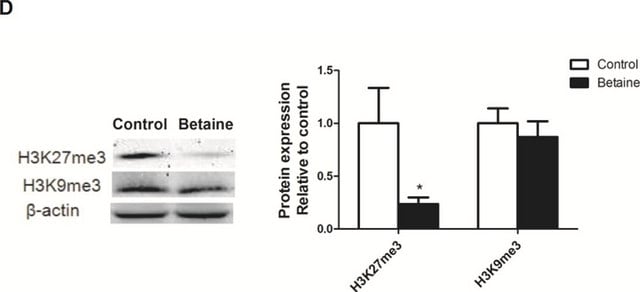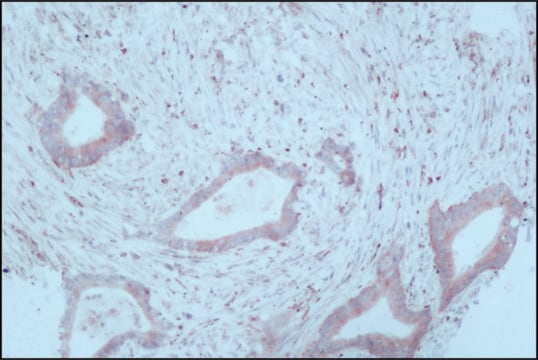MABS1920
Anti-IRF-9 Antibody, clone 6F1-H5
clone 6F1-H5, from mouse
동의어(들):
Interferon regulatory factor 9, IFN-alpha-responsive transcription factor subunit, ISGF3 p48 subunit, Interferon-stimulated gene factor 3 gamma, ISGF-3 gamma, Transcriptional regulator ISGF3 subunit gamma
로그인조직 및 계약 가격 보기
모든 사진(1)
About This Item
UNSPSC 코드:
12352203
eCl@ss:
32160702
NACRES:
NA.41
추천 제품
생물학적 소스
mouse
Quality Level
항체 형태
purified immunoglobulin
항체 생산 유형
primary antibodies
클론
6F1-H5, monoclonal
종 반응성
mouse
반응하면 안 됨
human
포장
antibody small pack of 25 μg
기술
ChIP: suitable
western blot: suitable
동형
IgG2aκ
NCBI 수납 번호
UniProt 수납 번호
배송 상태
ambient
타겟 번역 후 변형
unmodified
유전자 정보
mouse ... Irf9(16391)
일반 설명
Interferon regulatory factor 9 (UniProt: Q61179; also known as IRF-9, IFN-alpha-responsive transcription factor subunit, ISGF3 p48 subunit, Interferon-stimulated gene factor 3 gamma, ISGF-3 gamma, Transcriptional regulator ISGF3 subunit gamma) is encoded by the Irf9 (also known as Isgf3g) gene (Gene ID: 16391) in murine species. IRF-9 is a transcription factor that mediates signaling by interferon-alpha and beta. It contains 1 IRF tryptophan pentad repeat DNA-binding domain Following binding of these interferons to cell surface receptors, JAK kinases (Tyk2 ad JAK1) are activated that lead to tyrosine phosphorylation of STAT1 and STAT2. IRF-9 then associates with phosphorylated STAT1:STAT2 dimer to form the interferon-stimulated gene factor 3 (ISFG3) complex that translocates to the nucleus and binds to the interferon stimulated response element (ISRE) to activate the transcription of interferon-stimulated genes. In mice, ablation of IRF-9 is shown to block the proliferation and migration of vascular smooth muscle cells (VSMC) and attenuates intimal thickening in response to injury. On the other hand, IRF-9 gain-of-function is reported to promote VSMC proliferation and migration that can aggravates arterial narrowing. (Ref.: Zhang, SM et al (2015). Nat Commun. 6:6882).
특이성
Clone 6F1-H5 detects interfereon regulatory factor 9 (IRF-9) of 51 kDa in murine species. May also detect shorter variants of IRF-9.
면역원
Epitope: N-terminus
His-tagged full length recombinant longer version (465 amino acids) of murine Interferon regulatory factor 9.
애플리케이션
Anti-IRF-9, clone 6F1-H5, Cat. No. MABS1920, is a mouse monoclonal antibody that detects Interferon regulatory factor 9 (IRF-9). It has been tested for use in chromatin Immunoprecipitation and Western Blotting.
Chromatin Immunoprecipitation: Chromatin Immunoprecipitation was performed on a representative lot with wild -type or IRF9 knock-out bone marrow derived marcrophages (uninduced or treated with IFN beta). (Data courtesy of Prof. Thomas Decker, Ph.D., University of Vienna, Austria).
Research Category
Signaling
Signaling
품질
Evaluated by Western Blotting in mouse spleen tissue lysate.
Western Blotting Analysis: 0.5 µg/mL of this antibody detected IRF-9 in 10 µg of mouse spleen tissue lysate.
Western Blotting Analysis: 0.5 µg/mL of this antibody detected IRF-9 in 10 µg of mouse spleen tissue lysate.
표적 설명
~51 kDa observed. 44.61 kDa calculated. Uncharacterized bands may be observed in some lysate(s).
물리적 형태
Format: Purified
Protein G purified
Purified mouse monoclonal antibody IgG2a in buffer containing 0.1 M Tris-Glycine (pH 7.4), 150 mM NaCl with 0.05% sodium azide.
저장 및 안정성
Stable for 1 year at 2-8°C from date of receipt.
기타 정보
Concentration: Please refer to lot specific datasheet.
면책조항
Unless otherwise stated in our catalog or other company documentation accompanying the product(s), our products are intended for research use only and are not to be used for any other purpose, which includes but is not limited to, unauthorized commercial uses, in vitro diagnostic uses, ex vivo or in vivo therapeutic uses or any type of consumption or application to humans or animals.
Not finding the right product?
Try our 제품 선택기 도구.
Storage Class Code
12 - Non Combustible Liquids
WGK
WGK 1
시험 성적서(COA)
제품의 로트/배치 번호를 입력하여 시험 성적서(COA)을 검색하십시오. 로트 및 배치 번호는 제품 라벨에 있는 ‘로트’ 또는 ‘배치’라는 용어 뒤에서 찾을 수 있습니다.
Nasiha S Ahmed et al.
Proceedings of the National Academy of Sciences of the United States of America, 119(1) (2022-01-06)
Macrophages induce a number of inflammatory response genes in response to stimulation with microbial ligands. In response to endotoxin Lipid A, a gene-activation cascade of primary followed by secondary-response genes is induced. Epigenetic state is an important regulator of the
Catera L Wilder et al.
Molecular systems biology, 19(5), e11294-e11294 (2023-03-18)
Type I interferons (IFN) induce powerful antiviral and innate immune responses via the transcription factor, IFN-stimulated gene factor (ISGF3). However, in some pathological contexts, type I IFNs are responsible for exacerbating inflammation. Here, we show that a high dose of
Camila Marques-da-Silva et al.
Cell reports, 40(3), 111098-111098 (2022-07-21)
Malaria is a devastating disease impacting over half of the world's population. Plasmodium parasites that cause malaria undergo obligatory development and replication in hepatocytes before infecting red blood cells and initiating clinical disease. While type I interferons (IFNs) are known
Ekaterini Platanitis et al.
Nature communications, 10(1), 2921-2921 (2019-07-04)
Cells maintain the balance between homeostasis and inflammation by adapting and integrating the activity of intracellular signaling cascades, including the JAK-STAT pathway. Our understanding of how a tailored switch from homeostasis to a strong receptor-dependent response is coordinated remains limited.
자사의 과학자팀은 생명 과학, 재료 과학, 화학 합성, 크로마토그래피, 분석 및 기타 많은 영역을 포함한 모든 과학 분야에 경험이 있습니다..
고객지원팀으로 연락바랍니다.








